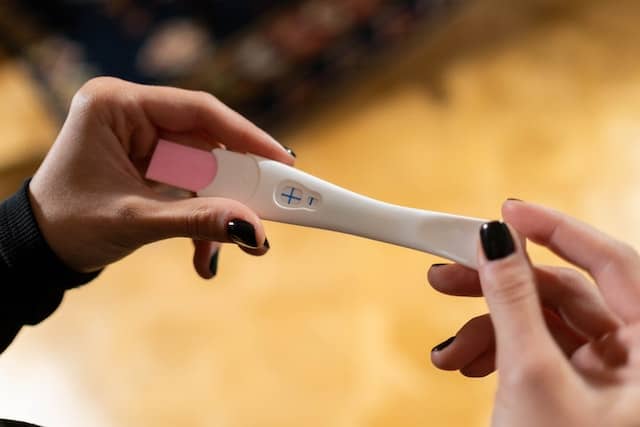A horizontal line on a pregnancy test can be a source of confusion and anxiety for those trying to conceive or those who suspect they may be pregnant. Understanding the meaning of this line and the factors that can affect its appearance is crucial for accurate interpretation of test results.
Pregnancy tests work by detecting the hormone human chorionic gonadotropin (hCG) in urine. When hCG levels are high enough, a positive result is indicated by the appearance of two lines on the test, one vertical and one horizontal.
However, in some cases, only the vertical line appears, leaving many wondering what it means.
There are several reasons why a horizontal line may appear on a pregnancy test. It could be due to a faulty test, a test that is past its expiration date, or improper use of the test.
Additionally, certain medical conditions or medications can cause a false positive or false negative result.
Understanding these factors and seeking medical advice when necessary can help alleviate the confusion and anxiety that may arise from a horizontal line on a pregnancy test.
Key Takeaways
- A horizontal line on a pregnancy test can be a source of confusion and anxiety.
- The appearance of a horizontal line can be due to various factors, including a faulty test, expired test, or improper use of the test.
- Seeking medical advice when necessary is important for accurate interpretation of test results.
Understanding Pregnancy Tests

Pregnancy tests are used to detect the presence of the pregnancy hormone human chorionic gonadotropin (hCG) in a woman’s urine. Most home pregnancy tests are designed to be simple and easy to use, with clear instructions provided in the packaging.
To use a home pregnancy test, a woman needs to collect a urine sample and then dip the testing stick into the urine or hold it in the stream of urine. The testing stick will then display the result in the result window, which usually takes a few minutes.
Different brands of pregnancy tests may have different symbols to indicate a positive or negative result, but most tests have a control line and a test line. The control line is used to confirm that the test is working correctly, while the test line indicates the presence of hCG.
A positive result is indicated by the appearance of a second line, which can be either a vertical line, a plus sign, or a second horizontal line. A negative result is indicated by the presence of only one line.
It is important to note that a faint line on the test does not necessarily mean a positive result. A faint line may indicate a low level of hCG, which could mean that the woman is in the early stages of pregnancy or that the test was taken too early.
The accuracy of home pregnancy tests varies depending on the brand and how well the instructions are followed. It is recommended to wait until at least the first day of a missed period before taking a pregnancy test to ensure the most accurate result.
In some cases, a horizontal line may appear in the result window, which can cause confusion for some women. However, a horizontal line is usually just a control line and does not indicate a positive or negative result.
Overall, home pregnancy tests are a convenient and reliable way for women to determine if they are pregnant. By following the instructions carefully and waiting until the appropriate time to take the test, women can obtain an accurate result and make informed decisions about their health and pregnancy.
Interpreting Test Results
After taking a pregnancy test, it is important to properly interpret the results to determine if you are pregnant or not. The test results will either be positive or negative, and it is important to understand what each result means.
A positive test result indicates that the pregnancy hormone, human chorionic gonadotropin (hCG), was detected in the urine. This hormone is produced by the placenta after a fertilized egg has implanted in the uterus.
A positive result can be indicated by a plus sign, a vertical line, or a horizontal line. It is important to note that a faint line is still considered a positive result, as long as it is visible within the time frame specified by the test instructions.
A negative test result indicates that hCG was not detected in the urine, and the person is likely not pregnant. A negative result can be indicated by a minus sign or a single horizontal line.
It is important to follow the test instructions carefully and read the results within the specified time frame. Waiting too long to read the results can result in an evaporation line, which can be mistaken for a positive result. An evaporation line is a faint line that appears after the test has dried, and does not indicate pregnancy.
It is also important to note that false positive and false negative results can occur. A false positive result is when the test indicates a positive result when the person is not actually pregnant. This can occur due to certain medications or medical conditions that can cause hCG to be present in the urine.
A false negative result is when the test indicates a negative result when the person is actually pregnant. This can occur if the test is taken too early or if the hCG levels are not high enough to be detected by the test.
In summary, understanding how to properly interpret pregnancy test results is crucial in determining pregnancy. Carefully following the test instructions and reading the results within the specified time frame can help avoid confusion and ensure accurate results.
Common Issues and Solutions

Pregnancy tests are designed to be easy to use, but there are some common issues that can arise. Here are some of the most common issues and their solutions:
1. Faulty Tests
Sometimes, a test can be faulty or defective. This can happen if the test was damaged during shipping or if it was stored improperly. If you suspect that your test is faulty, contact the manufacturer for a replacement.
2. Expiration Date
Pregnancy tests have an expiration date printed on the packaging. Using an expired test can result in inaccurate results. Always check the expiration date before using a test.
3. Instructions
Following the instructions is crucial to getting accurate results. Make sure you read and follow the instructions carefully. If you are unsure about any part of the instructions, contact the manufacturer for clarification.
4. False Positives
A false positive result occurs when the test indicates that you are pregnant when you are not. This can happen if you have recently had a miscarriage or if you are taking certain medications. If you get a positive result and you are not sure if it is accurate, talk to your doctor.
5. False Negatives
A false negative result occurs when the test indicates that you are not pregnant when you are. This can happen if you take the test too early or if you have a low level of the pregnancy hormone in your urine. If you get a negative result and you are not sure if it is accurate, wait a few days and take another test.
6. Evaporation Lines
An evaporation line is a faint line that can appear after the test has been sitting for a while. It is not a positive result and should not be interpreted as such. Always read the test results within the time frame specified in the instructions.
7. Indent Lines
An indent line is a faint line that can appear where the test line would be if you were pregnant. It is not a positive result and should not be interpreted as such. Always read the test results within the time frame specified in the instructions.
8. Cup
Some tests come with a cup for collecting urine. It is important to use the cup provided and to follow the instructions for collecting the urine. Using a different cup or not following the instructions can result in inaccurate results.
Medical Consultation and Advice

If a woman is unsure about the results of her pregnancy test, she should seek medical consultation and advice. A doctor or healthcare provider can help interpret the results and provide guidance on next steps.
In some cases, a blood test may be recommended to confirm pregnancy. This test can detect pregnancy earlier than a home pregnancy test and can also measure the levels of the pregnancy hormone hCG in the blood.
If a woman is taking fertility medications or has been trying to conceive, it is especially important to consult with a doctor or healthcare provider. These factors can affect the accuracy of pregnancy test results and may require additional testing or monitoring.
It is also important to seek medical advice if a woman suspects she is pregnant but is experiencing unusual symptoms or complications. These may include heavy bleeding, severe cramping, or signs of infection.
Overall, seeking medical consultation and advice can help ensure accurate pregnancy test results and provide necessary guidance for women who are trying to conceive or have concerns about their pregnancy.
Emotional Aspects of Pregnancy Testing

Pregnancy testing can be an emotional experience for many women. The possibility of being pregnant can bring up a range of emotions, including excitement, anxiety, fear, and uncertainty. The emotional impact of a positive or negative pregnancy test result can also be significant.
For many women, the decision to take a pregnancy test is a family decision. They may discuss the possibility of pregnancy with their partner, and together they may decide to take a test.
If the result is positive, they may experience a range of emotions together, including joy, excitement, and anticipation. If the result is negative, they may experience disappointment or sadness.
News and media coverage of pregnancy testing can also play a role in the emotional aspects of testing. News stories about unexpected pregnancies or fertility struggles can create anxiety and uncertainty for women who are considering testing.
It is important to remember that every woman’s experience is unique and that the media does not always accurately represent the realities of pregnancy testing.
It is also important to note that not all women experience the same emotions when taking a pregnancy test. Some may feel indifferent or even relieved at a negative result, while others may feel devastated.
It is important for women to have a support system in place, whether that be a partner, family member, or friend, to help them navigate the emotional aspects of pregnancy testing.
In summary, pregnancy testing can be an emotional experience for many women. The decision to take a test is often a family decision, and news and media coverage can play a role in shaping women’s expectations and emotions.
It is important for women to have a support system in place to help them navigate the emotional impact of a positive or negative result.
Pregnancy Loss and Its Impact on Test Results
Pregnancy loss, also known as miscarriage, can have an impact on the results of a pregnancy test. A pregnancy test works by detecting the hormone human chorionic gonadotropin (hCG), which is produced by the cells of the fertilized egg.
If a pregnancy ends in a loss, the level of hCG in the body will decrease, which can affect the accuracy of the test.
There are different types of pregnancy loss, including chemical pregnancy, early pregnancy loss, and missed period. In a chemical pregnancy, the fertilized egg implants in the uterus but does not develop properly and is lost soon after.
This can cause a positive pregnancy test result, but the levels of hCG will drop quickly, leading to a negative result shortly after. Early pregnancy loss occurs when a pregnancy ends in the first 12 weeks, and missed period is when a woman does not have her period when expected.
If a woman experiences a pregnancy loss, it is important to wait until her body has had time to recover before taking another pregnancy test. This can take several weeks, depending on the type of loss and how far along the pregnancy was. Taking a test too soon after a loss can result in a false positive or false negative result.
In some cases, a woman may have a fertilized egg that implants outside of the uterus, known as an ectopic pregnancy. This can also affect the results of a pregnancy test, as the levels of hCG may not rise as expected.
It is important to seek medical attention if a woman suspects an ectopic pregnancy, as it can be life-threatening.
In conclusion, pregnancy loss can impact the results of a pregnancy test, and it is important to wait until the body has had time to recover before taking another test. It is also important to seek medical attention if there are any concerns about the pregnancy.
Different Types of Pregnancy Tests

There are several types of pregnancy tests available in the market. The most common ones are home pregnancy tests, also known as at-home pregnancy tests.
These tests are designed to detect the presence of human chorionic gonadotropin (hCG), a hormone that is produced by the placenta after a fertilized egg implants in the uterus.
Home pregnancy tests come in two different types: digital tests and non-digital tests. Digital tests display the results on a digital screen, while non-digital tests use lines or symbols to indicate whether the test is positive or negative.
Another way to categorize pregnancy tests is by the type of dye that is used. There are two types of dyes: red dye and blue dye. Red dye tests are considered more reliable than blue dye tests, as they are less likely to produce false positives.
Clearblue is a popular brand of home pregnancy tests that offers both digital and non-digital tests. Clearblue tests are known for their high sensitivity, meaning they can detect pregnancy at an early stage.
Sensitive pregnancy tests are another type of home pregnancy test that can detect pregnancy earlier than most other tests. These tests are designed to detect lower levels of hCG in the urine, making them more accurate in the early stages of pregnancy.
In summary, there are several types of pregnancy tests available, including digital and non-digital tests, red dye and blue dye tests, and sensitive tests. Clearblue is a popular brand that offers both digital and non-digital tests with high sensitivity. When choosing a pregnancy test, it is important to consider its sensitivity and reliability.
Pregnancy Tests and Fertility Medications
Pregnancy tests are a common tool used by women to determine if they are pregnant. However, when a woman is taking fertility medications, the results of a pregnancy test may not be as straightforward.
Fertility medications are often prescribed to women who are trying to conceive but are having difficulty getting pregnant. These medications work by stimulating ovulation, increasing the chances of fertilization. However, some fertility medications can also affect the results of a pregnancy test.
For example, medications containing human chorionic gonadotropin (hCG), such as Ovidrel and Pregnyl, can cause a false positive on a pregnancy test. This is because hCG is the hormone that is produced during pregnancy and is detected by most pregnancy tests.
Women who are taking fertility medications should wait at least two weeks after their last injection before taking a pregnancy test. This will give the medication enough time to leave their system and ensure that the results of the test are accurate.
It is important to note that while fertility medications can increase the chances of getting pregnant, they do not guarantee pregnancy. Women who are trying to conceive should speak with their doctor about the best course of treatment for their individual needs.
Pregnancy Test Brands and Their Features
There are several pregnancy test brands available in the market, each with its unique features and sensitivities. Some of the most popular brands include Clearblue, First Response, EPT, and Equate.
Clearblue is a widely recognized brand that offers digital tests with a clear result display. Their digital tests are particularly useful for women who find it challenging to interpret traditional line tests.
Clearblue tests use blue dye, which is less prone to evaporation lines and is known for providing accurate results.
First Response is another popular brand that offers both digital and traditional line tests. Their tests use red dye, which is known to be more sensitive and can detect pregnancy earlier than blue dye tests.
First Response tests are also known for their accuracy, with a claimed accuracy rate of over 99%.
EPT is a brand that offers traditional line tests with a curved design, making it easier for women to hold and use. EPT tests also use red dye, which is known for its sensitivity and can detect pregnancy early on.
Equate is a more affordable brand that offers traditional line tests with both blue and red dye options. Equate tests are known for their accuracy and can provide accurate results as early as 4 days before a missed period.
It is essential to note that the sensitivity of pregnancy tests varies between brands. Some tests can detect pregnancy as early as 6 days before a missed period, while others may require a missed period to provide accurate results. It is crucial to read the instructions carefully and follow them to ensure an accurate result.
Baby Products for Expecting Parents
As an expecting parent, there are several baby products that you will need to ensure that you and your baby are comfortable and well taken care of. Here are some of the essential baby products that every expecting parent should consider:
- Diapers: Diapers are a must-have for any parent with a newborn. You can choose between disposable and cloth diapers depending on your preference and budget. It is recommended to have at least 10-12 diapers per day for a newborn.
- Baby Wipes: Baby wipes are essential for cleaning up your baby’s messes. You can choose between scented and unscented wipes depending on your preference. It is recommended to have a stock of baby wipes at home and in your diaper bag.
Baby Clothes:
- Swaddle Blankets: Swaddle blankets are essential for keeping your baby warm and cozy. They can also be used as a nursing cover or a burp cloth.
- Baby Carrier: A baby carrier is a great way to keep your baby close and your hands free. There are several types of baby carriers available, including wraps, slings, and structured carriers.
- Breast Pump: If you plan on breastfeeding, a breast pump can be a lifesaver. It allows you to pump and store milk for when you are away from your baby.
- Baby Monitor: A baby monitor allows you to keep an eye on your baby while they sleep. There are several types of baby monitors available, including audio and video monitors.
- Car Seat: A car seat is essential for transporting your baby safely in a car. Make sure to choose a car seat that is appropriate for your baby’s age and weight.
These are just a few of the essential baby products that every expecting parent should consider. Make sure to do your research and choose products that fit your budget and lifestyle.
Related posts:
Frequently Asked Questions
What does a faint horizontal line on a pregnancy test mean?
A faint horizontal line on a pregnancy test can indicate a positive result, but it is important to note that the line should be read within the time frame specified in the instructions. If the line appears after the specified time, it may be an evaporation line, which is not a reliable indicator of pregnancy.
What does a line across mean on a pregnancy test?
A line across a pregnancy test, whether faint or bold, typically indicates a negative result. It is important to read the instructions carefully and follow them exactly to ensure accurate results.
Is a horizontal line positive or negative?
A horizontal line on a pregnancy test can indicate a positive result, but it is important to read the instructions carefully and follow them exactly to ensure accurate results. If the line appears after the specified time, it may be an evaporation line, which is not a reliable indicator of pregnancy.
What does it mean when you get a horizontal EVAP line on your negative pregnancy test?
An evaporation line on a pregnancy test is a faint, colorless line that can appear after the specified time frame. It is not a reliable indicator of pregnancy and should not be interpreted as such.
If you have concerns about your test results, it is recommended to consult with a healthcare professional.
What does evaporation line look like?
An evaporation line on a pregnancy test is typically a faint, colorless line that appears after the specified time frame. It can be mistaken for a positive result, but it is not a reliable indicator of pregnancy.
What are some common causes of a faint horizontal line on a pregnancy test?
A faint horizontal line on a pregnancy test can be caused by a variety of factors, including an early stage of pregnancy, a low level of the pregnancy hormone hCG, or an evaporation line. It is important to read the instructions carefully and follow them exactly to ensure accurate results.
If you have concerns about your test results, it is recommended to consult with a healthcare professional.

Iesha is a loving mother of 2 beautiful children. She’s an active parent who enjoys indoor and outdoor adventures with her family. Her mission is to share practical and realistic parenting advice to help the parenting community becoming stronger.
